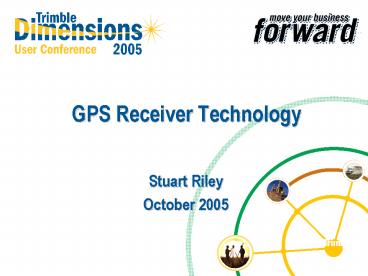GPS Receiver Technology - PowerPoint PPT Presentation
1 / 31
Title:
GPS Receiver Technology
Description:
Various Radio Modem Options. Low Elevation Tracking System Performance ... PRN 17 Currently Unhealthy. L2C Signal Strength. L2C Productivity Advantage ... – PowerPoint PPT presentation
Number of Views:146
Avg rating:3.0/5.0
Title: GPS Receiver Technology
1
GPS Receiver Technology
- Stuart Riley
- October 2005
2
Overview
- New Technologies Performance
- GPS Modernization Testing
- Multipath
- RTK Performance
3
Wideband Antenna L1/L2/L5
- Based on Proven Zephyr Technology
4
Maxwell Evolution
Power W
Maxwell V
Maxwell
Maxwell III
Maxwell IV
5
RF Improvements
- IF RF SAW Filters
- New flexible RF ASIC
6
Increased Integration
L1/L2/L5 RF Bands
L1/L2 RF Bands
7
Trimble R8 GNSS Features
- L1/L2/L5 Signal Tracking
- Negligible power penalty with L5 tracking
- Bluetooth for cable less operation
- Removable Rechargeable Battery
- External Power Input
- New Zephyr Derivative Antenna Element
- Updated design to include L5
- New CPU
- Increased onboard data logging
- Various Radio Modem Options
8
Low Elevation Tracking System Performance
- UNAVCO TEQC software observed to expected
9
High Elevation Tracking System Performance
- UNAVCO TEQC software observed to expected
10
Repeatability of Zephyr Antenna PCV
- 10 Samples
- lt0.2mm L1
- lt0.4mm L2
11
Zephyr Code Multipath Rejection
- MP1 and MP2 statistics from TEQC software
12
Civil L2
- Two codes, one with and one without message data
- Serves both commercial and consumer interests
- Code characteristics
- Codes longer than C/A to minimize cross
correlation - Time multiplexed, alternate code chips
- Combined chip rate is 1.023 MHz
- Average clock rate for each code is 511.5 kHz
- 20 msec code with 10,230 chips
- 1.5 sec code with 767,250 chips (gt 45 dB
correlation protection) - First Satellite Transmission 2005-10-21
- PRN 17 Currently Unhealthy
13
L2C Signal Strength
14
L2C Productivity Advantage
- 84 36 degree Elevation
15
Civil L5
- I-channel
- 50Hz data
- Encoded with FEC 100bps
- Encoded with 1KHz 10-symbol Neuman-Hoffman Code
- Modulated with X(I) code at 10.23MHz
- Modulated onto the carrier
- Q-channel
- No data message
- Encoded with 1KHz 20-symbol Neuman-Hoffman Code
- Modulated with X(Q) code at 10.23MHz
- Modulated onto the carrier
16
L2C/L5 Testing
- JPO L2-C / L5 Modulator Tests
- L1/L2/L5 Simulator
17
The Multipath Problem
- Multipath occurs when multiple copies of a
satellite signal arrive at the antenna from
different paths
SV 8
SV 8
SV 8
18
How Multipath Occurs
SV 8
- Multiple copies are created when the satellite
signal reflects off of objects near the antenna
SV 8
SV 8
SV 8
19
Three Satellite 8s ???
SV 8
SV 8
SV 8
- Three signals confuse the receivers signal
correlation process causing range errors.
SV 8
SV 8
SV 8
20
Code Tracking Basics
Receiver PN Code
Input base-band samples
- Channel multiplies the reference PN with the
input samples - Result goes into an integrate-and-dump filter
- Error phase between reference and input data,
error filtered - and applied to hardware.
- Multipath adds a second (or more) image of the
PN code to - input samples.
21
Code Tracking Discriminator
Punctual (P)
Late (L)
Early (E)
Tracking Error Chips
-1
1
22
Code Tracking Discriminator
- Shape is rounded in a real receiver
- Any unpredicted distortion may cause a code
tracking error - Error is filtered and used to maintain lock and
provide the pseudorange observable.
23
Code Tracking ACF
1.5
1
0.5
ACF
0
-0.5
-4
-2
0
2
4
1.5
1
0.5
ACF
0
-0.5
-4
-2
0
2
4
Delay Chips
24
Code Tracking ACF
- Transitions from constructive to destructive
interference - L1 Carrier Wavelength 19cm
- Rate of change determined by environment
- High rate of change multipath is filtered by code
smoothing
25
Generic Narrow Correlator Error Envelope
Multipath Envelope
8
6
4
2
0
Multipath Error Metres
-2
-4
-6
-8
0
50
100
150
200
250
300
350
Multipath Delay Metres
26
DGPS Comparative Analysis
- 24-Hour Data Set
- Short base-line on flat roof
- Trimble Receiver with Everest Installed
27
Stationary Range Comparison
- Stat. Rng. Pseudorange - Accumulated delta
range - Ionospheric divergence modeled
- Provides pseudorange noise (including multipath)
comparison.
28
Stationary Range Example
Trimble Everest 1-Sigma 18.16cm
2
1
Stat. Rng. m
0
-1
-2
0
1000
2000
3000
4000
X 1-Sigma 33.51cm
2
1
0
Stat. Rng. m
-1
-2
0
1000
2000
3000
4000
Time Seconds
29
Real-TimeDGPS Tests
Without Everest
Everest
30
RTK Performance
- New RTK engine tested in real-time and with
regression data - Significant improvements in time to initialize
while maintaining solution integrity - New RTK and other receiver enhancements yield
31
Questions ?

